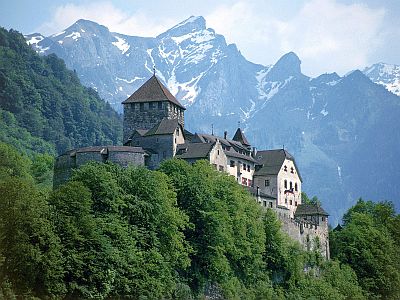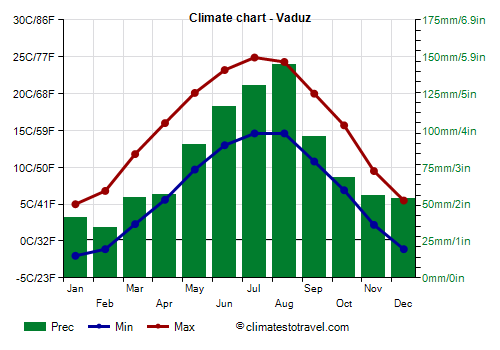Select units of measurement for the temperature and rainfall tables (metric or imperial).
Average weather, temperature, rainfall, sunshine
The climate in Liechtenstein is
continental at low altitude, while it's
Alpine in the mountains.
Liechtenstein is a small country, covering an area of 160 square kilometers (60 square miles) and located between Austria and Switzerland. To the west is the valley of the
Rhine River, which flow from south to north, at an altitude of 480 to 430 metres (1,575 to 1,410 feet). In the eastern part, instead, the are
mountains, the highest peak being Grauspitz, 2,600 meters (8,500 ft) high.
The climate in detail
The seasons
In
winter, from December to February, cloudy and dull days are frequent, accompanied with rain or snow, typically light but continuous. Sometimes, while the sky is overcast in the valley, the sun shines in high mountains.
On the other hand, outbreaks of polar air masses of Siberian origin can bring glacial weather, with maximum temperatures below freezing everywhere.
The
Föhn, the southerly wind, warm and dry, coming down from the mountains, is more frequent in autumn, and can lead to sudden increases in temperature.
In
summer, from June to August, temperatures are generally pleasant and suitable for outdoor activities, although there may be rains and thunderstorms, most likely in the afternoon or evening.
Sometimes, hot periods can occur, usually of short duration, which in recent years are becoming more frequent due to global warming, and in which the temperature can exceed 32 °C (89.5 °F) in the valley.
In
high mountains, where the climate is colder and windier, snowfall can occur for a longer period, depending on altitude. In the mountains, precipitation is more abundant than in the valley and exceeds 2,000 mm (80 in) per year: the abundant winter snowfalls are replaced by the strong summer thunderstorms.

Vaduz

The capital, Vaduz, is situated in the Rhine Valley, at 450 meters (1,450 ft) above sea level. In Vaduz and in the valley, the climate is
continental, cold in winter, with a daily average temperature in January around freezing (0 °C or 32 °F), and relatively warm in summer, with maximum temperatures around 24/25 °C (75/76 °F) in July and August.
The cold record is -21 °C (-6 °F), recorded in January 1968, while the heat record is 36 °C (97 °F), recorded in August 2003.
Average annual
precipitation in Vaduz is around 950 millimeters (37.5 inches), with a maximum due to thunderstorms from June to August. In the other months of the year, the rains are quite frequent, brought by Atlantic fronts, but they are rarely abundant. In winter, precipitation often occurs in the form of snow.
The
sun in Liechtenstein is rarely seen from November to February, especially in the valley bottom. In summer, it shines a little more often, especially in the morning, while in the afternoon, thunderclouds can develop even in periods of good weather. In total, Vaduz receives 1,500 hours of sunshine per year – less than London and Paris.
When to go
The best time to visit Liechtenstein runs from
mid-May to late September, when the weather is mild or pleasantly warm during the day, but cool at night in the valley (and even cold in the mountains). However, there can be some cool and rainy days, and afternoon thunderstorms are frequent, especially in the mountains.
What to pack
In
winter: bring warm clothes, a hat, a down jacket, a scarf, gloves, and a raincoat or umbrella.
In
summer: bring clothes for spring and autumn, a T-shirt, but also long pants, a jacket, a sweatshirt or sweater for the evening and for cooler days; a raincoat or umbrella. For the mountains, bring a sweater, a jacket, hiking shoes, sunscreen and sunglasses.
Climate data - Liechtenstein
| Vaduz |
|---|
|
| Jan | Feb | Mar | Apr | May | Jun | Jul | Aug | Sep | Oct | Nov | Dec |
|---|
| Min temp. | -2 | -1 | 2 | 6 | 10 | 13 | 15 | 15 | 11 | 7 | 2 | -1 |
|---|
| Max temp. | 5 | 7 | 12 | 16 | 20 | 23 | 25 | 24 | 20 | 16 | 10 | 6 |
|---|
| Precip. | 40 | 35 | 55 | 55 | 90 | 115 | 130 | 145 | 95 | 70 | 55 | 55 |
|---|
| Prec. days | 7 | 7 | 9 | 9 | 12 | 13 | 13 | 13 | 10 | 9 | 9 | 9 |
|---|
|
| Day length | 9 | 10 | 12 | 14 | 15 | 16 | 15 | 14 | 12 | 11 | 9 | 9 |
|---|
| Sun hours | 2 | 3 | 4 | 5 | 5 | 6 | 6 | 6 | 5 | 4 | 2 | 2 |
|---|
|